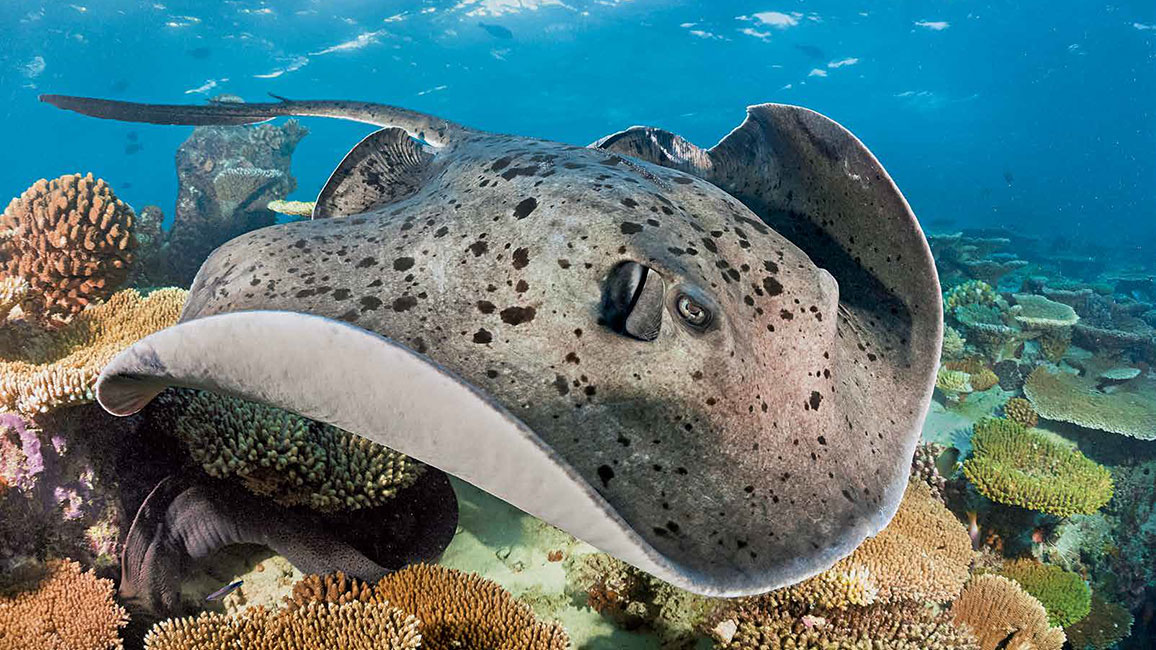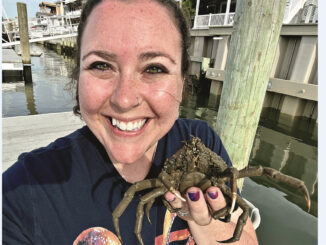
Amazing Rays
By Kathy KrankingCheck out this ray, flapping its way across a reef. A pancake-shaped body might seem strange to you, but for a ray, it’s flat-out fantastic!
So, what exactly is a ray? A ray is a kind of fish. Rays are very close cousins of sharks. As a matter of fact, if you could flatten out a shark with a rolling pin, you’d have a ray! (Almost, anyway.)
There are about 630 species of rays, and, though some of them live in freshwater, most live in the ocean. Depending on the species, rays are found in cold waters, warm waters, along coasts, or far offshore.
A flat body works great for the way most rays live. To find out why, keep reading!
BUILT FOR THE BOTTOM
A ray spends a lot of time on the ocean floor, so its flat body comes in very handy. The ray can lie there, partly buried in sand, and be hidden from enemies as well as from prey it may snatch. Its eyes are on the top of its body, so it can still see what’s going on when the rest of its body is buried.
The ray’s mouth, though, is located on the bottom of its body. So the ray can easily hunt by gliding its flat body along the bottom, gobbling up clams, oysters, shrimp, and other prey as it goes. Rays also hunt by using their wing-like fins to stir up sand on the bottom. Then they gobble up uncovered prey. Most rays have rows of flat teeth for crushing their crunchy food.
BREATHIN’ EASY
A ray’s body plan also works great when it comes to breathing. Most fish get oxygen from water as it flows through their mouths and then back out through their gills. But if a ray breathed through its mouth when it was buried, it would get a mouthful of sand! So instead, it draws water in through two openings on the top of its body, called spiracles (SPEER-uhkuhlz). (You can see a spiracle behind the eye of the ray on pages 6–7.) As water flows into a ray’s spiracles, the ray absorbs oxygen from the water. Then the water goes back out through the ray’s gill slits, which are on the bottom of its body.
BIG MOUTHS, TINY FOOD
Some kinds of rays spend more time swimming around in open water rather than lying on the bottom. A number of these free swimmers will gobble up fish as they swim and also search for food such as shrimp or clams on the bottom. But other free-swimmers eat only plankton, tiny creatures that drift along in the water. Plankton-eating rays have their big, wide mouths at the front of their bodies—the better for sucking in lots of plankton as the rays swim along. And plankton-eaters usually breathe through their mouths rather than through spiracles.
AN ARRAY OF RAYS
When people hear the word “ray,” they often think of stingrays. Stingrays have venomous barbs at the base of their tails. If they feel threatened, they can give a painful sting. But stingrays are just one of many families of rays. Most rays are completely harmless.
Rays come in different sizes, shapes, and colors. (See the variety of rays above.) The smallest ray is the size of a pancake. And the largest is so big that three grownups could lie head-to-toe across its back with room to spare! That’s the famous giant manta ray. This big ray has a big mouth, but it eats tiny plankton—sometimes as much as 60 pounds a day. Like other plankton-eating rays, mantas have flipper-like fins that they use to channel food toward their mouths.
BABY FLATTIES
Some kinds of fish hatch from eggs, and some kinds come out live from their mothers. Rays do both! After mating, a female ray has an egg (or eggs, depending on the species) inside her body, in which a baby ray grows. When the time is right, the baby hatches from the egg inside the mom. It continues growing, and then later the mom pushes the baby out of her body. The new ray swims off to begin life on its own!
This article originally appeared in the June/July 2017 issue of Ranger Rick magazine.



















